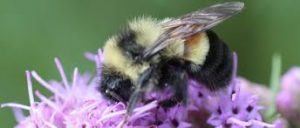04
Feb
Take Action: Help Protect Endangered Bumblebees
 (Beyond Pesticides, February 4, 2019) Although the rusty patched bumblebee was placed on the endangered species list in 2017, the Trump Administration has failed to put in place legally required safeguards for the species. The U.S. Department of the Interior (DOI) must designate locations where additional protections could help restore the endangered bumblebee’s population.
(Beyond Pesticides, February 4, 2019) Although the rusty patched bumblebee was placed on the endangered species list in 2017, the Trump Administration has failed to put in place legally required safeguards for the species. The U.S. Department of the Interior (DOI) must designate locations where additional protections could help restore the endangered bumblebee’s population.
DOI’s failure to comply with requirements under the Endangered Species Act (ESA) is consistent with the Trump Administration’s continued disregard for ongoing pollinator declines and environmental protections in general. Under ESA, DOI is required to determine “critical habitat” that contains physical and biological requirements a listed species needs in order to recover. That area must be designated within one year of placing a species on the endangered list, using best available scientific data. The Trump Administration’s DOI has failed to do so under either former Director Ryan Zinke or Acting Director David Bernhardt. Without determining critical habitat, the administration is in violation of the ESA, and the survival of a critical endangered species is threatened.
The rusty patched bumblebee has a historical range that included habitat throughout the Northeast and Midwest United States. The Washington Post notes that, “The rusty patched bumblebee was so prevalent 20 years ago that pedestrians in Midwestern cities had to shoo them away.” However, pesticide use, climate change, disease, and habitat loss led to significant declines over the last several decades. Since then, their populations have dwindled and their overall decline is estimated at 91 percent.
The Trump Administration has dragged its feet on protecting the rusty patched bumblebee since the beginning of its term. The species was proposed for ESA listing under the Obama Administration in 2016, and finalized in 2017 only a week before the new Administration took office. However, on his first day in office, President Trump directed federal agencies to postpone the effective date of any regulations that had been published to the federal register but not yet put into effect. This move effectively reversed the ESA listing of the rusty patched bumblebee. In March 2017, the species was finally placed onto the endangered list.
Unfortunately, the Trump Administration’s actions in this case are more of the norm rather than the exception. In August of last year, DOI reversed a long-standing policy that prohibited the use of systemic, bee-toxic neonicotinoid insecticides on National Wildlife Refuges. The Administration has also worked on the pesticide industry’s behalf to slow down the implementation of farmworker protections and continue the allowance of another highly toxic insecticide chlorpyrifos.
Letter to Congress
Under the Endangered Species Act (ESA), the Department of the Interior (DOI) is required to determine “critical habitat” that contains physical and biological requirements a listed endangered species needs in order to recover. That area must be designated within one year of placing a species on the endangered list, using best available scientific data. DOI has failed to do so, in violation of the ESA. Without this action, survival of a critical endangered species is threatened.
The rusty patched bumblebee has a historical range that included habitat throughout the Northeast and Midwest United States. The Washington Post notes that, “The rusty patched bumblebee was so prevalent 20 years ago that pedestrians in Midwestern cities had to shoo them away.” However, pesticide use, climate change, disease, and habitat loss led to significant declines over the last several decades. Since then, their populations have dwindled and their overall decline is estimated at 91 percent.
DOI must ensure preservation of the rusty patched bumblebee by designating critical habitat, or the bee will become extinct.
Sincerely,











save the bumble bee please
February 4th, 2019 at 2:34 pmplease save the bumble bees
February 4th, 2019 at 2:35 pmWithout Bees, humanity and all living things will soon follow the fate of the Bees.
February 4th, 2019 at 5:05 pm